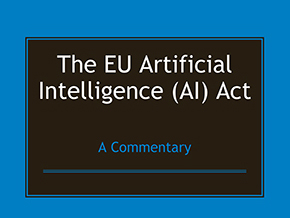Introduction to AI Regulation
The Chair AI Regulation proudly highlights the involvement of its researchers in the book “The EU Artificial Intelligence (AI) Act: A Commentary” (Wolters Kluwer). This book is a comprehensive commentary on the EU Artificial Intelligence Act, which aims to regulate the development and use of artificial intelligence in the European Union.
Contributions to the Book
The Chair’s Research Fellow, Dr. Theodoros Karathanasis, contributed with a commentary on “Article 17 – Quality Management System” of the AI Act. The commentary explains the Article’s requirements, including aspects like risk management, data governance, and post-market monitoring. It examines the legal background, drawing on international standards (ISO, OECD) and existing EU legislation. The analysis clarifies the scope of application, particularly concerning financial institutions and public authorities. Finally, it details the process of achieving compliance through conformity assessment, highlighting the roles of notified bodies and the interplay with sectoral regulations.
Article 16 Commentary
Dr. Stavros Tsipras (former research fellow of the Chair) contributed with a commentary on “Article 16 – Obligations of Providers of High-Risk AI Systems” of the AI Act. The commentary outlines numerous requirements, including compliance with safety and data regulations, transparency measures, and accessibility provisions. The text further explores the international context, comparing the EU’s approach with similar legislation in Canada, Brazil, and China, highlighting variations in terminology and implementation. A risk-based approach is central, with obligations tailored to the level of risk posed by the AI system. Finally, the document clarifies the roles of various actors in the AI value chain, including providers, developers, and deployers, and addresses the importance of harmonised standards and the ‘state of the art’.
Support and Acknowledgments
These contributions are attributable only to the authors and do not necessarily reflect the view of the other members of the AI-Regulation Chair or any partner organizations. These works have been partially supported by MIAI @ Grenoble Alpes, (ANR-19-P3IA-0003) and by the Interdisciplinary Project on Privacy (IPoP) commissioned by the Cybersecurity PEPR (ANR 22-PECY-0002 IPOP).
Conclusion
The involvement of the Chair AI Regulation researchers in the book “The EU Artificial Intelligence (AI) Act: A Commentary” demonstrates their expertise and commitment to regulating artificial intelligence. Their contributions provide valuable insights into the requirements and obligations of the AI Act, which will help shape the future of AI development and use in the European Union.
FAQs
Q: What is the EU Artificial Intelligence Act?
A: The EU Artificial Intelligence Act is a regulation that aims to regulate the development and use of artificial intelligence in the European Union.
Q: What are the main requirements of Article 17 of the AI Act?
A: The main requirements of Article 17 include risk management, data governance, and post-market monitoring.
Q: What are the obligations of providers of high-risk AI systems under Article 16 of the AI Act?
A: The obligations include compliance with safety and data regulations, transparency measures, and accessibility provisions.
Q: Who supported the research works?
A: The research works were partially supported by MIAI @ Grenoble Alpes and the Interdisciplinary Project on Privacy (IPoP) commissioned by the Cybersecurity PEPR.











